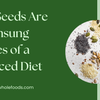Stoneground Flour and Artisan Baking: Why Bakers Love It
- by K V
In the world of artisan baking, stoneground flour has emerged as a favorite among both home bakers and professionals. Known for its rich flavor, nutritional benefits, and rustic quality, stoneground flour offers a unique baking experience that highlights the natural goodness of whole grains.
Unlike conventional flours, which are typically milled using high-speed steel rollers, stoneground flour retains the bran and germ of the grain, preserving essential nutrients, fiber, and flavor. This traditional approach to milling has captured the attention of bakers looking to create more wholesome, flavorful breads and pastries. As a result, stoneground flour has seen a resurgence in popularity, particularly in the artisanal baking community, where quality, texture, and taste are paramount.
What is stoneground flour?
Stoneground flour is made using a traditional milling process that involves grinding whole grains between large stones. This method crushes the entire grain, including the bran, germ, and endosperm, allowing for a fuller flavor and greater nutrient retention. In contrast to modern roller milling, which separates the parts of the grain and removes the bran and germ, stone milling keeps these nutrient-dense components intact. This results in a flour that not only has a more robust flavor but also offers a range of vitamins, minerals, and fiber that are typically lost in refined flours.
Stoneground Milling vs. Roller Milling
- Stoneground Milling: The process is slower and gentler, which helps preserve the integrity of the grain. The stones grind the grain at a cooler temperature, minimizing nutrient loss and retaining essential oils, which contribute to the flour's rich flavor and texture.
- Roller Milling: In contrast, roller milling involves high-speed steel rollers that separate the bran and germ from the endosperm, producing a finer, whiter flour that has a longer shelf life but lacks many of the nutritional and flavor benefits found in stoneground flour.
Types of Grains Used for Stoneground Flour
Stoneground flour can be made from a variety of grains, each bringing a distinct flavor and texture to baked goods:
- Wheat: Whole wheat stoneground flour is the most common, offering a nutty flavor and hearty texture, ideal for rustic breads and pastries.
- Rye: Stoneground rye flour is favored for its dense, earthy flavor, commonly used in traditional breads like sourdough and pumpernickel.
- Spelt: Known for its light, nutty taste, spelt is an ancient grain that is easier to digest than modern wheat, making it a popular choice for artisan baking.
- Other Grains: Other grains like corn, barley, and oats are also stoneground to create unique flours that add texture and depth to recipes, making them perfect for creative, flavorful baking.
Stoneground flour offers a return to traditional, whole-grain baking that celebrates natural flavors and the craftsmanship of baking with high-quality ingredients.
Nutritional Benefits of Stoneground Flour
- High Fiber Content: Stoneground flour retains the bran, providing ample fiber that supports digestive health and helps maintain steady blood sugar levels.
- Rich in Essential Nutrients: Contains key vitamins and minerals like B vitamins, iron, magnesium, and zinc, which support energy production, immune health, and overall vitality.
- Antioxidants and Healthy Oils: Retains the germ, which is rich in antioxidants and healthy oils that support heart health and reduce inflammation.
- Better Digestibility: Many find stoneground flour easier to digest, as it contains natural enzymes and nutrients that aid in digestion and reduce bloating.
- Lower Glycemic Index: Due to the retention of whole-grain components, stoneground flour generally has a lower glycemic index, which helps prevent spikes in blood sugar.
Recipes for you to try out!
Whole Wheat Sourdough Bread
- Description: This sourdough bread has a hearty texture and a slightly tangy flavor that comes from the fermentation process. The stoneground whole wheat flour provides a rich, nutty taste and a chewy crust.
- Key Ingredients: Stoneground whole wheat flour, sourdough starter, water, salt.
- Tips: Allow the dough to rise slowly overnight for the best flavor, and consider using a Dutch oven for a crisp crust.
Rye and Spelt Loaf
- Description: A dense, flavorful loaf made with stoneground rye and spelt flour, perfect for sandwiches or toast. This bread is packed with fiber and has a slightly earthy taste that pairs well with savory toppings.
- Key Ingredients: Stoneground rye flour, stoneground spelt flour, yeast, water, salt, honey or - molasses.
- Tips: Rye flour is less elastic, so be gentle with the dough and allow for a longer rise to develop flavor.
- Description: This pizza dough, made with a blend of stoneground whole wheat and bread flour, has a crispy, chewy texture with a subtle nuttiness. It’s a fantastic base for any toppings, giving your homemade pizza a rustic flair.
- Key Ingredients: Stoneground whole wheat flour, bread flour, yeast, water, olive oil, salt.
- Tips: Allow the dough to rest for at least 10 minutes after mixing and consider using a pizza stone for a crispier crust.
- Description: These biscuits are lightly sweetened and have a hearty texture from stoneground whole wheat flour. They’re ideal for breakfast or as a side with soups and stews.
- Key Ingredients: Stoneground whole wheat flour, baking powder, butter, milk or buttermilk, a pinch of sugar and salt.
- Tips: Handle the dough lightly and avoid over-mixing to keep the biscuits tender. Bake at a high temperature for a golden crust.
- Description: Moist and flavorful banana muffins made with stoneground flour, perfect for a wholesome snack or breakfast. The whole grains add a nutty flavor that complements the natural sweetness of bananas.
- Key Ingredients: Stoneground whole wheat flour, ripe bananas, baking soda, eggs, oil or butter, honey or maple syrup, cinnamon.
- Tips: Add nuts or dark chocolate chips for extra texture. Don’t over-mix to keep the muffins tender.
In conclusion stoneground flour offers a unique baking experience that combines tradition, flavor, and nutrition. Its rich, nutty taste and hearty texture set it apart from conventional flours, making it a favorite among artisan bakers and home cooks alike. By preserving the bran and germ, stoneground flour provides essential nutrients, fiber, and healthy oils, contributing to both the flavor and health benefits of baked goods.
From sourdough bread to rustic pastries, this flour enhances the character of each recipe, inviting bakers to explore the depth and variety of whole grains. If you're looking to elevate your baking with wholesome ingredients that bring out the natural taste of the grain, stoneground flour is the perfect choice to try in your kitchen. Embrace its rustic quality, and enjoy the full, satisfying flavors it brings to your creations!





